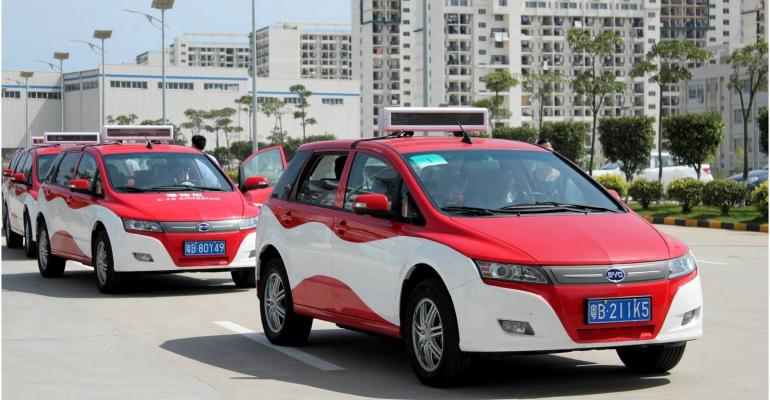After years of rapid growth, China’s auto industry is entering a period of relative stability despite pressure for economic consolidation and from environmental concerns that are driving the government’s push for more electrical vehicles, according to U.S. experts.
At a recent panel discussion at the University of Michigan, Michael Jackson of IHS Automotive says while China’s growth rate is slowing, leaders hope to see the economy gain 6.5% under the country’s latest 5-year plan. But he says that seems overly optimistic under current conditions. “We see a lower growth rate, but (within) a much larger economy,” he notes.
Car sales in massive Tier 1 cities such as Shanghai and Beijing have been curtailed by stiff regulations, but sales in smaller cities will continue to grow, Jackson says.
Auto sales in China topped 24.5 million units in 2015 and will continue rising at a modest but steady clip over the next several years, reaching more than 30 million units annually in the next decade and solidifying the country’s position as one of the global auto industry’s primary engines for growth.
John Jullens, a principal with PWC Strategy Consulting Group in Detroit, predicts the compound annual growth rate of auto sales in China, which reached 21% between 2003 and 2013, will slow sharply. However, growth is expected to average 5% yearly between 2015 and 2023 and sales could top 30 million units annually by 2020, thanks to changing lifestyles in small cities and steady infrastructure improvements throughout the country.
The growth will create new opportunities for luxury cars where the preference for “back-seat” drivers is fading and “front-seat” drivers of high-end makes are becoming more popular among younger Chinese consumers, Jullens says.
Panelists also note other trends shaping the auto industry in China. One is the steady growth of joint ventures of companies aligned with Volkswagen and General Motors, which have emerged as the market leaders. With sales of more than 3.7 million and 3.4 million units, respectively.
GM and Volkswagen-Audi dwarf the joint ventures of rivals such as Hyundai-Kia, Nissan and Toyota, according to data assembled for the conference by Bruce Belzowski, managing director-Automotive Futures Group at the University of Michigan’s Transportation Research Institute.
JVs Thriving But Many Local Manufacturers Struggle
At the same time, the indigenous Chinese industry, including established brands such as Great Wall, Geely, Chery and BYD, have made a name for themselves within the global industry, faces serious challenges. “There is no doubt there is a need for consolidation,” Jackson says.
But the local auto industry also includes dozens of smaller firms that are struggling with issues such as overcapacity. Consolidation has been slow largely because most of the smaller companies are owned and supported by local governments across China, which are reluctant to see their auto plants swallowed by a larger enterprise, Belzowski says.
The international JVs’ market share currently is 60%. But they are under pressure as a price war, particularly at the lower end of the market, rages across China, according to Steve Golden of Clean Diesel Technologies.
Diesel vehicles’ role is limited but the Chinese government’s effort to promote small gasoline engines with less than 1.6L displacement has boosted domestic manufacturers, which are becoming more and more adept at developing small engines, he notes.
China now is the market with not only the lowest new-vehicle prices but also the most stringent emissions standards, Golden says.
At the same time, the government’s push to electrify vehicles ranging from city buses and taxis to small vehicles no larger or powerful than a golf cart has complicated efforts to consolidate China’s highly fragmented production system.
Sergio Muniz, a visiting researcher at UMTRI, says China emerged in 2015 as the world’s largest market for so-called new-energy vehicles, which include battery-electric and plug-in hybrid vehicles that can travel more than 30 miles (50 km) on electric power with one charge. Sales of new-energy vehicles in China, which has some of the world’s worst air pollution, have doubled in 2016 from preior-year, according to the most recent estimates presented at the conference.
The government has committed to offering $15 billion in incentives through 2020 to encourage development of new-energy vehicles, Muniz says, adding the subsidies can range up to 60% of the vehicle’s price. Of the EVs and PHEVs sold in China, 95% are built locally, with luxury imports from Tesla and Porsche accounting for most of the balance.
In addition, EVs have become easier to license in China’s largest cities under government policies aimed at fighting pollution, reducing dependence on imported oil and promoting leadership in EV technology, says Muniz, who estimates as many as 4,000 new EV models are under development in the country.
Up to Speed on Ride Sharing, Intelligent-Vehicle Research
Ming Xu, a professor in the University of Michigan’s School of Natural Resources, says China also is quickly emerging as a leader in new business models such as ride-sharing, which already is becoming second nature to consumers. Chinese entrepreneurs have become adept at developing phone apps and software to facilitate ride sharing, he says.
The Chinese are also keenly interested in developing intelligent vehicles, panelists agree.
Jullens notes an executive with Baidu, the Chinese equivalent of Amazon and Google combined, makes no secret of China’s ambition.
“With electric cars, with intelligent cars, the core technology shifts from the engine and gearbox to artificial intelligence,” he says. A senior Baidu executive recently observed that’s an area where China is very close to the U.S. and has the potential to catch up and seize leadership, Jullens says.
Chinese automakers also are expanding globally and have opened or soon will open auto plants in far-flung places such as Kazakhstan, India. Thailand, Indonesia, the Philippines, Iran, Algeria, Russia and Brazil, and the Chinese industry’s global footprint likely will grow in coming years, Jackson says.





